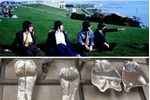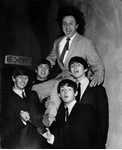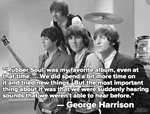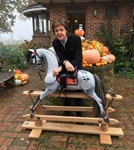- Register
- Log in to Tune-In
- Wishlist (0)
-
Shopping cart
(0)
You have no items in your shopping cart.
Beatles News

An impressive collection of John Lennon's fans and peers will gather to celebrate what would have been the singer-songwriter's 75th birthday this year with a star-studded tribute concert. Willie Nelson, Aerosmith's Steven Tyler, the Killers' Brandon Flowers, Sheryl Crow and Eric Church will all perform at New York City's Theater at Madison Square Garden on December 5th to honor the former Beatle in a program titled Imagine: John Lennon 75th Birthday Concert. The show will be broadcast on AMC on December 19th at 9 p.m. EST.
Other performers include Peter Frampton, Kris Kristofferson, Tom Morello, Aloe Blacc, Juanes, Train's Pat Monahan, Chris Stapleton and the Roots. The show's producers will announce more performers prior to the concert. "It's beautiful to see so many wonderful and talented musicians come together for this special show to celebrate John's birthday," Yoko Ono said in a statement. "John's art continues to give hope, light and happiness to generations of people everywhere. His belief that each of us can change the world continues to inspire the human race to believe in themselves, and his influence is everlasting in everyone's hearts as we all share in the possibilities and power of music."
details
Visitors to the Hoe will soon be able to recreate the famous Beatles photograph - by sitting on copper moulds of the fab four's bums.
A unique piece of modern art will be unveiled at the spot where the stars once sat on the Hoe. Casts of four fab butts have been laid in the ground where John, Paul, George and Ringo posed for a picture that has gone on to become one of the most famous images of arguably the best band of the 1960s – or ever.
The image was taken by music photographer David Redfern and shows ‘The Fab Four’ with an all-white Smeaton’s Tower in the background. They were in the city to pose for photographers while making ‘The Magical Mystery Tour’ film.
Now Beatles fans can recreate the image of this famous picture by sitting on the Hoe on copper bottom moulds made by Thrussell and Thrussell, a duo of artist metalsmiths based on Bodmin Moor. They were ably assisted by top UK tribute band The Fab Beatles, whose bottoms were used to create the moulds. Each member of the band was lowered into a sand pit to create an initial impression. Concrete was then poured in to create the moulds. These shaped the copper that has been used to create the artwork. The finished details

We’ve been told the story for more than fifty years: Beatlemania hit after The Beatles arrived in America and performed on The Ed Sullivan Show on February 9, 1964. It was the rock’n’roll equivalent of the Big Bang.
But is this the truth? Actually, no.
In a case of almost criminal historical oversight (revisionism?), Beatlemania hit Canada long before that Pan Am flight landed in New York. Months before Beatles songs started going up the US charts, the band had hits in Canada.
“Love Me Do” was released in Canada on February 18, 1963, by Capitol Records but, truth be told, it was a stiff, selling less than 200 copies. “Please Please Me” and “From Me to You” came next, each selling about 300 copies. But when “She Loves You” hit the stores in September, everything went crazy and all the other records started selling. Canada embraced the Beatles months before America.
And there’s more. The term “Beatlemania” appears to be the invention of A Canadian journalist. Sandy Gardiner was an entertainment writer for the Ottawa Journal. While visiting England, he learned of the hysteria Beatles were causing. When he wrote about details

If you happen to be a music fan, wouldn't you want to visit the place where The Beatles wrote almost their entire self-titled White Album? The place where Ob-La-Di, Ob-La-Da, While My Guitar Gently Weeps, Mother Nature's Son, Sexy Sadie, and Abbey Road's Maxwell's Silver Hammer and Mean Mr Mustard were conceptualised?
"Sit beside a mountain stream, see her waters rise Listen to the pretty sound of music as she flies Doo doo doo.... Find me in my field of grass, Mother Nature's son Swaying daisies, sing a lazy song beneath the sun."
The mountain stream in question is the mighty Ganga, and the songs were all written during the band members' retreat to Maharishi Mahesh Yogi's ashram in Rishikesh.
The ashram, abandoned in 1997, is slowly being reclaimed by the forest and overrun by wild animals. But the Uttarakhand forest department, which owns the land, has come up with a way to utilise its fame and the Beatles connection.
The forest department wants to promote eco-tourism - by introducing bird watching and a nature walk. The ashram is being spruced up and will be thrown open for tourists this month.
By: Raju Gusain
Source: Catch News

The music of Ringo Starr was celebrated on January 20th, 2014 at a tribute concert in Los Angeles, an event that also saw the Beatles drummer honored with the Lifetime Of Peace & Love Award on behalf of the David Lynch Foundation. That tribute show featured the Head and the Heart, Joe Walsh, Ben Folds, Ben Harper and even Starr himself tackle the Rock and Roll Hall of Famer's best-known works. Nearly two years later, the special concert will be released as Ringo Starr: The Lifetime of Peace & Love Tribute Concert on December 4th.
Ark Life, Brendan Benson and Bettye LaVette also performed Starr favorites at the gig, with Don Was serving as musical director and performing as part of a house band that featured Peter Frampton, Kenny Aranoff, Steve Lukather and Benmont Tench. Proceeds from the record will benefit the David Lynch Foundation, which aims to bring transcendental meditation to at-risk populations worldwide.
Ringo Starr: The Lifetime of Peace & Love Tribute Concert Track List
1. Ark Life - "Can't Do It Wrong"
2. The Head and the Heart - "Octopus's Garden"
3. Brendan Benson - "Don't Go Where The Road Don't Go"
By: Daniel Kreps
Source: Rolling S details

They were, of course, brilliant musicians – but we shouldn’t forget they could probably have made decent careers as comedians, too. I loved immersing myself in the classic Fab Four Fest that was The Nation’s Favourite Beatles Number One (ITV, Wednesday). The music was, naturally, great – but so was John, Paul, George and Ringo’s easy and natural humour.
Watching them joking with comedy giants like Ken Dodd and Morecambe and Wise was a sheer joy, with the band playing the parts of the comedians’ equals rather than their stooges, or straight men. Doddy could make mincemeat – or jam from a jam butty mine – out of almost anyone, but not The Beatles.
The Squire of Knotty Ash was chatting to them about a potential pop persona. He was thinking “Cliff or Rock” – to which Paul said: “Or Cliff Dodd... Rock Dodd.” And when Doddy invited suggestions for an “earthy name”, John’s deliciously dry reply was “Sod.”
There was also a delightful exchange between John and Eric Morecambe – after John said: “My dad used to tell me about you” (his hand indicating when he was knee high), Eric replied: &ld details

One of the most memorable moments from the Beatles’ film Help!, the “Another Girl” sequence provides the template for the modern music video with its vivid colors, quick cuts, exotic locale, and hints of sex. Yet underneath the bouncy tempo and twanging lead guitar lies a darker meaning: instead of a straightforward love song, Paul McCartney penned a song filled with aggression and a cavalier attitude toward commitment. While he praises his new love, he derides his previous girlfriend and sums up his attitude in one line: “I ain’t no fool and I don’t take what I don’t want.”
In Barry Miles’ Many Years from Now, McCartney explains that he composed the song while on vacation in Tunisia. He wrote the lyrics and music in the bathroom of a private villa, due to its optimal acoustics. “Another Girl” was not released as a single, but McCartney resisted calling it merely album “filler.” “I think they were a bit more than that, and each one of them made it past the Beatles test,” McCartney told Miles. “We all had to like it. If anyone didn’t like one of our songs it was vetoed. It could be vetoed by one person. If Ringo said, &l details

As a Beatle, Sir Paul McCartney could get anything he wants, whenever he wants it. But the Liverpool legend has a very modest rider for his newly announced gig at Chris Evans’ pub. Warrington-born DJ Chris revealed Sir Paul - who has agreed to do the fundraiser for Children In Need - has made “few requests”.
He said: “He wants some mineral water - still, he’d like some organic dips, and some vegetables and a bowl of fruit.” Macca will be the headline act at the 10th annual Dine and Disco for Children in Need next year.
The special show will take place on Saturday June 25 at The Mulberry Inn to an audience of just 80 auction winners.
Chris announced the news on his Radio 2 breakfast show yesterday as part of his auctions for Children In Need. The new Top Gear host said: "We’ve had loads of people play over the last 10 years. Next year it’s the 10th anniversary of the Dine and Disco at my pub, therefore it’s the last one ever. “It was always going to be the last one anyway - and it's so serendipitous that Paul McCartney has agreed to play it.”
Sir Paul went on air yesterday to speak to Chris about why he decided to help out. All the details

There is a tendency to think of music videos as originating in the Eighties, the era of MTV and Michael Jackson’s Thriller, when every major single would be accompanied by a short film, marrying music with visuals in ways intended to enhance the song and market the artist’s image. But, in common with so many pop innovations, The Beatles got there first.
The newly released Beatles 1+ DVD features 50 promos of the Fab Four, sweeping viewers from a charmingly static black and white mop top performance of Love Me Do in 1963 to a full colour, windswept, wild and funky romp through Don’t Let Me Down on the roof of the Apple building in 1969. No other recording artists of the era accrued anything like this kind of visual record.
“It was very unusual at the time,” notes Sir Michael Lindsay-Hogg, who directed Beatle promos for Paperback Writer, Rain, Hey Jude and Revolution. “They weren’t thinking about the future, no one envisioned MTV.” Yet Lindsay-Hogg, who was 26 when he started working with the Beatles, was never in doubt of the significance of these innocent, early promos. “Society was changing and music was in the vanguard. The appearance of the musicians, thei details

The rock legend tells Billboard the origin stories -- some moving, some bawdy -- behind eight of The Beatles' record-breaking 20 No. 1 hits.
More than 50 years after the release of their debut single, "Love Me Do," principally written by a then-16-year-old Paul McCartney, The Beatles remain the Billboard Hot 100's biggest act of all time. Even in 2015, the band's accomplishments still stagger: 34 top 10 hits, 50 songs in the top 40 and the most No. 1s in a calendar year (six in 1964 and five in 1965) -- plus, McCartney, John Lennon, George Harrison and Ringo Starr are the only artists to take over the Hot 100's top five positions simultaneously. The deluxe reissue of The Beatles' 1 hits collection, released Nov. 6 and featuring the following eight indelible classics, is expected to make a top 10 debut on the Billboard 200.
In late 1962, The Beatles began to blitz the United Kingdom with effusively energetic songs, but America initially took a skeptical view of their music, as well as their girlish haircuts. "The big story about 'I Want to Hold Your Hand,' " recalls McCartney, "I'd said to Brian [Epstein, the band's manager], 'We don't want to go to America until we have a No. 1 record.' A lot of British artists details

I’ve got a bone to pick with The Nation's Favourite Beatles Number One. Hippy-dippy ballads such as We Can Work It Out and Let It Be finished far too high in the list, while rock classics Paperback Writer and Hard Day’s Night didn’t get the status they deserved. Every viewer doubtless had their own quibbles, too. Ranking Beatles songs is always a hiding to nothing but that’s the beauty of such exercises - they’re a controversy-stirrer and conversation-starter.
The week that their greatest hits collection, 1, got a deluxe bells-and-whistles re-release, ITV capitalised with this evocative two-hour tribute, framed around a public poll. The Mersey moptops notched 27 chart-topping singles in the UK and US, hence we counted down viewers’ favourites from 27 to one.
As always with such hagiographies, the great and good queued up to offer soundbites. There was pop royalty such as Bjorn from Abba, Tito Jackson, Lamont Dozier, Noel Gallagher and Sandie Shaw (sadly, it was a headshot so we couldn’t tell if she was barefoot). There were fans from the Sixties, such as model Twiggy and actress Sue Johnston. There were random celebrities, including David Tennant, Michael Palin, Ken Dodd details

When Brian Wilson of the Beach Boys heard the Beatles' Rubber Soul for the first time, he knew something in pop had changed.
"I listened to Rubber Soul, and I said, 'How could they possibly make an album where the songs all sound like they come from the same place?'" Wilson said in the 2008 documentary The Beach Boys and the Satan. "I couldn't deal with it. It blew my mind. And I said, 'Damn it, I've got to do that. I've got to try that with the boys.'
" He saw it as the first pop album without any filler, and it likely was. It hit stores at a time when the industry was far more focused on singles, and records were largely viewed as methods to house them. It inspired Wilson to write Pet Sounds, a highly symphonic masterpiece, which in turn inspired the Beatles' Sgt. Pepper's the Lonely Hearts Club Band. It was arguably the greatest musical conversation that has ever existed. These three albums — Rubber Soul, Pet Sounds and Sgt. Pepper's the Lonely Hearts Club Band — all sit in the top of Rolling Stone's "500 Greatest Albums" of all time, Nos. 5, 2 and 1, respectively.
Beyond just inspiring Wilson, Rubber Soul challenged all of pop music to step up and start seeing albums as artistic wholes an details

Andy White, the Scottish studio session musician who played the drums on Love Me Do and other early tracks by The Beatles, has died in New Jersey. According to his family, the 85-year-old died on Monday following a stroke. White was chosen ahead of Ringo Starr in September 1962 to play drums on the single version of Love Me Do and its B-side, P.S. I Love You. White, who was born in Glasgow in 1930, is also believed to have played on the album version of Please Please Me. He could therefore legitimately claim to be one of the so-called "Fifth Beatles", alongside the likes of Pete Best, Stuart Sutcliffe and others.
White also played drums on Lulu's 1964 cover of Shout and Sir Tom Jones' 1965 single It's Not Unusual. He went on to tour with Marlene Dietrich, Burt Bacharach and Rod Stewart and perform with the BBC Scottish Radio Orchestra. In a 2009 interview with a New Jersey newspaper, White revealed he was often called to London's Abbey Road studios in the 1960s. "I would get a call from EMI and you never knew what you were going to be asked to do," he told The Progress.
White was paid a one-off fee - £5 - for his three hours with the Beatles and received no subsequent royalties. Starr, who played drums on details

To mark ITV's broadcast of 'The Nation's Favourite Beatles Number One' we take a look through the archives to see what links the Fab Four to this county we call home.
It was back on Friday June 21 1963 the band played to an audience in Guildford, in their one and only visit to the town. John Lennon, Paul McCartney, Ringo Starr and George Harrison were the headline act on the Jimmy Crawford Package Show. The band headlined two concerts at the Odeon in the upper High Street. Scores of screaming fans were in tow waiting to hear the band of the moment and their many hits. Some braves fans even tried to scale the wall in Sydenham Road in an attempt to get into The Beatles' dressing room.
At the time the Surrey Advertiser's sister paper, the Guildford and Godalming Times, reported on the gig. The reviewer said: “The Beatles did their best to sing above the deafening screams of the audience. “I recognised their hit numbers but most of the words were inaudible.”
Even though the band did not frequent the music venues of Surrey, they did see the appeal of the county as three out of the four band members have at one point called Surrey their home. John Lennon lived in Kenwood, St George's Hill in details

Paul McCartney Signs Rocking Horse for Alder Hey Children’s Hospital Auction “Let’s get rocking for Alder Hey!"
This Christmas, one very lucky child could be receiving a personalised rocking horse signed by Paul. The horse – made by Stevenson Brothers – features Paul’s signature along with a handwritten lyric from the classic Beatles song ‘Lucy in the Sky with Diamonds’: “Rockin’ horse people eat marshmallow pies!!"
The signature and Beatles quote are not the only ties the wooden steed has to Paul: Stevenson Brothers – who have previously designed rocking horses for ‘Her Majesty' the Queen - modeled this particular creation not on “Henry the horse” who of course “dances the waltz”, but on Paul’s own Appaloosa named ‘Moonstar’, copying both his colouring and markings.
On top of this, Paul has also placed an additional surprise inside a “secret locking chamber” that’s been built into the underside of rocking horse!
This one-of-a-kind rocking horse is now up for auction to raise funds for the Alder Hey Children’s Hospital in Liverpool and will be exclusively details
